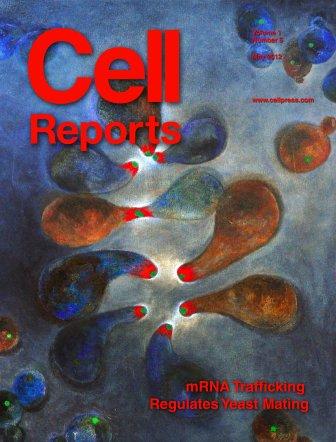Yeast cells yearning for a “soul mate” have a problem: They lack the ability to move on their own. To get closer to a potential mate, all they can do is reach out with cellular extensions. This enables a pair of yeast cells to make contact, after which they fuse their membranes together and ultimately merge their genomes.
Prof. Jeffrey Gerst of the Weizmann Institute’s Molecular Genetics Department has now discovered the mechanism that controls the growth of yeast cell extensions called shmoos in a particular direction, making sure the cells can engage in successful mating. This same control mechanism is predicted to govern the growth of cellular extensions in organisms other than yeast – for example, the growth of neurons towards attractive signals or away from repellent signals in the human brain.
The scientists found that when yeast cells ready for sexual reproduction receive a chemical signal from a prospective “mate,” they respond by sending specific messenger RNA (mRNA) molecules – whose job is to convey DNA-encoded information to be translated into proteins – to the point on their membrane where the mating signal has been received. This prompts the cells to start growing shmoos in the direction of the mate, a process called chemotropism. They also revealed how mRNA reaches this location: They identified a protein, called Scp160, that is activated by the mating signal and guides the needed mRNAs to the appropriate spot near the cell surface. When the scientists created a mutation in Scp160, disrupting its activity, yeast cells grew extensions in the wrong direction and failed to mate. Taking part in
the study, published recently in
Cell Reports, was Rita Gelin-Licht, then Gerst’s graduate student, as well as Saurabh Paliwal, Patrick Conlon and Andre Levchenko of Johns Hopkins University.
In earlier research, Gerst had already shown that mRNA movements around the cell are not random; rather, its protein-making information is targeted to the exact spot or spots where this protein will eventually be needed. In the present study, Gerst and his team showed for the first time that mRNA targeting is crucial for the cell to respond properly to external chemotropic signals.
If these findings are found to be applicable to neurons, they might shed new light on the wiring of the human brain. They may help explain how the brain neurons grow the lengthy projections that link up into precise neural networks that transmit electric signals throughout the brain.
Prof. Jeffrey Gerst's research is supported by the Miles and Kelly Nadal and Family Laboratory for Research in Molecular Genetics; the Hugo and Valerie Ramniceanu Foundation; the Y. Leon Benoziyo Institute for Molecular Medicine; the Yeda-Sela Center for Basic Research; and the estate of Raymond Lapon. Prof. Gerst is the incumbent of the Besen-Brender Professorial Chair of Microbiology and Parasitology.

